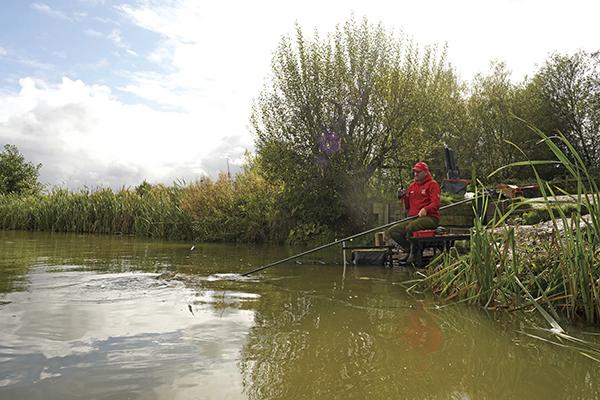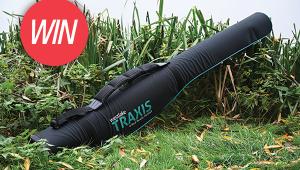PVA Equals Bigger Fish

Barston is the home of the Method/Hybrid feeder. There have been more matches won here using this tactic than any other. But, in recent times, this killer method has lost a lot of its potency. The reason being that there has been an explosion of 4 to 6oz skimmers and this is what is making the Method/Hybrid untenable as a match winner.
These shoals of silver fish are attacking your micro pellets like piranha, so within minutes you are simply left with an empty feeder and an orange wafter hook bait. Basically, you are fishing a straight lead, when you don’t necessarily want to be!
Into this mix has come PVA. Perceived as being a purely specialist angler’s approach, PVA is now starting to make significant inroads on the match and pleasure fishing circuits.
PVA, or to give it is Sunday name, Poly Vinyl Alcohol, is soluble in water. This means that you’re able to place your loose bait directly around the hook bait in a very neat pile, giving the perfect presentation, every time.
The other major advantage is that you are able to use any loose feed that you care to mention – hard pellets, soft pellets, corn or maggots and it is the former that I have turned to, to keep the nuisance fish at bay. By using PVA bags of hard 8mm or even 6mm – I prefer 8mms – you know that you are presenting a loose feed that is wholly small skimmer-proof. It follows the old saying of “Big baits, big fish.”
Although a lot of anglers are fearful of using hard pellets as autumn turns to winter, I reckon that as our seasons change and generally become much milder, I am 100 per cent confident fishing hard pellets up to Christmas and beyond. I’ve been at Boddington in the past couple of years and witnessed anglers fishing and catching on the pellet waggler during a mild day during the Christmas holidays.
The Beauty Of PVA
Although carp and specialist anglers have used it for years, the match scene has been a little slower in ‘getting on it’, although I and a lot of anglers I know have been using it as part of our winter/cold water armoury for a number of years now. The biggest and main advantage is that you can loose feed hard baits, big baits or both. I have even used corn in the past, as long as it’s not wet so the PVA doesn’t melt prior to the cast; it’s a great way of getting these types of baits at a much longer range than you normally would be able to.
Another advantage of using PVA is that you can pretty much chuck it anywhere in the lake and fully expect to get a bite. Like fishing a single hook bait, you’re fishing for a bite at a time rather than having to fish accurately over a large bed of bait, something that the feeder angler is forced to do. Of course, I have a main swim for the day, but if I see a fish or two crash in the same area, away from where I am currently fishing, I have no qualms in casting to these showing fish. It’s a great way to put a few bonus carp in the net, particularly at a time of the year when carp bites are at a bit of a premium. If you don’t get a bite within 10 to 15 minutes, simply reel in, fix on another bag and cast back on to your main area.
It’s a great way of looking for the fish, particularly when the water is very cold and the carp are tightly shoaled. You end up going to them, rather than having to wait an age for them to find your bed of bait. That is if they are prepared to move at all, which they usually aren’t in winter.
Compared to the time-honoured feeder approach, fishing small PVA bags can sound like a very negative approach as you’re only feeding a palmful at a time. But, feeding too much in cold water can be the kiss of death.
When it comes to PVA bags and cold water, there is only one slight disadvantage. The colder the water, the slower the PVA will melt, which means that it could take a few minutes before the loose feed is revealed, meaning that you are not fishing effectively during this time.
To combat this, I like to fish mine using a Kobra PVA bag feeder. These feeders are just like Method feeders, except they have no tines to hold the pellets or groundbait in place, plus they have a length of pole elastic running top to bottom, which holds the PVA bag in place.
Once in the water, this elastic pushes down on the bag, helping it to break down quicker. I’m confident that even in the coldest water, my PVA will have melted and be fishing within 60 to 90 seconds, the same way I would be if using a traditional Method feeder.
Kobra Feeders
The feeders I use are a low-walled Method-feeder style with pole elastic to hold the PVA payload. The beauty of these compared to a standard bomb and PVA approach is that similar to the Method, I can place my hook bait directly in the pile of loose feed, so of the carp want to feed on the free baits, they can’t avoid my hook bait. There is also no messing around with stringer needles, having to thread the bags onto the hook link etc, which slows you down in a match.
Also, being based around a Method feeder, these Kobra feeders cast so much better than a bomb and bag will. With a bomb, you need to use a longer hook link, say 12 inches; this sees the presentation tumbling through the air, rather than casting like a bullet as a slimline feeder will. It is these extra valuable yards, especially in cold clear water, that can put more fish in the net. There is also no chance of the rig tangling on the cast either, meaning that you don’t waste a cast if you don’t notice the tangle.
Finally, you don’t have to use a big bomb that is heavier than the bag, again to avoid tangles, as the PVA bag is fixed to the feeder itself. I like to use either a 34g or 28g feeder, but usually it is the heavier ones as I find they cast better at the ranges I’m looking fish – around 50 metres or more.
Pepping Things Up
As PVA is water-soluble, you need to keep everything dry – lots of anglers tend to tie up a bait box full of bags prior to their match. Be careful not to use too high an oil pellet as the oil will soak into the PVA overnight, greatly affecting the PVA’s breakdown rate. I recommend standard carp pellets. The problem here though is that they are fairly boring!
I overcome this is two easy ways. The first is to dip the loaded feeder into a PVA-friendly dip or glug. There are lots of these on the market, just use one you like the look/smell of!
The other way is to colour and/or flavour your pellets. I use Ringers Sweet Energy. Simply pour over a little of the liquid on to the pellets, shake and leave to soak in. This will help your loose feed stand out from the crowd and help you catch a few more. You are only using 10 to 15 pellets per bag so I feel like you need to do a little something to help flag up their presence in the water.
Fishing The PVA Bag
Today I’m at Barston, but on any large open water like this, I tend to start my sessions at the 50m mark. I find this a nice comfortable distance to cast and it allows me plenty in the tank to cast further should I need to follow the fish out or if they are sitting further from the bank.
If you start too long, you have nowhere to go if the fish move away; conversely, if you start too short, you may miss out on a few early fish.
Time-wise, I tend to look at recasting every 15 to 20 minutes. As I’m not using micros, which the skimmers will quickly devour, I can be confident that I will always have loose feed surrounding my hook baits. For the hook bait, I go one of two ways. The first is to ‘match the hatch’, using the same 8mm pellet on the hair that I’m using in the PVA bags. Being more old school, I prefer to drill the pellets and hair-rig them, as I think they present and fish better than a banded pellet. It also means that I can use two pellets on the hair if needs be.
As an alternative hook bait, I use one of my Ringers Washout Wafters. Wafters have been devasting as a hook bait in the past few years, so I don’t think there is a better bait to use in this scenario. I also use Pellet Wafters as a ‘similar but different match the hatch’ style hook bait.
Regards the tackle, here everything is fairly standard. I’m using a Daiwa SLR rod with 6lb line and an 8lb Technium shockleader, to take the sting out of the cast, and a 0.22mm Guru hook link to a size 10 QM1 hook. This may all sound quite big and heavy, but at the end of the day I’m fishing for big carp so I need to go along the specimen line. I’ve had a 30-pounder from Barston in the past, as well as a rake of 20lb fish from here and places like Boddington, so going too light is a false economy in my eyes.
Apart from this little tweaks, fishing PVA via a Kobra feeder is pretty much the same as using a Method or Hybrid feeder, only without the headache of getting plagued by lots of tiny skimmers!
- Log in or register to post comments













